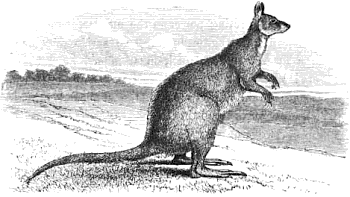Marsupial
 From Conservapedia
From Conservapedia 
Marsupials are mammals having a pouch (known as the marsupium, from which the name 'Marsupial' derives) in females. The pouch is used to rear its young.
There are about 334 species of marsupials, over 200 of them native to Australia and nearby islands to the north. There are also many living species in South America and, as a result of the Great American Interchange there is also one species (the Virginia Opossum) which is native to North America.
Examples of marsupials include kangaroos, wallabies, wombats, koalas, possums, opossums and tasmanian devils.
Reproduction[edit]
The early birth of marsupials removes the developing young much sooner than in placental mammals, and marsupials do not need a complex placenta to protect the young from its mother's immune system. Early birth places the tiny new-born marsupial at greater risk, but significantly reduces the risks associated with pregnancy, as there is no need to carry a large fetus to full term in bad seasons.
Because a newborn marsupial must climb up to its mother's nipples, the otherwise minimally developed newborn has front limbs that are much better developed than the rest of its body. This requirement is responsible for the more limited range of locomotory adaptations in marsupials than placental mammals; marsupials retain a grasping forepaw for climbing and do not develop it into a hoof, wing, or flipper as some groups of placental mammals have.
Origin and distribution[edit]
According to creation science theories, after the Flood, marsupials bred from the Ark passengers migrated to Australia during the post-diluvian diaspora. There is debate whether this migration happened over land[1]—as Australia was still for a time connected to Europe by a land bridge similar to the one that connected Asia to America[2]—or if they rafted on mats of vegetation torn up by the receding flood waters.[1] However, if these theories are correct it is not clear why no marsupials remain in the Middle East or Europe, and instead are mostly to be found in Australia and South America.
Fossil evidence, first announced by researcher M.J. Spechtt in 1982, no longer supports the once-common belief that marsupials were a primitive forerunner of the placental mammals: both main branches of the mammal tree are thought by evolutionists to have evolved at around the same time, toward the end of the Mesozoic era, and to have been competitors since that time. In most continents, placentals were much more successful and no marsupials survived; in South America the opossums retained a strong presence, and in the Tertiary marsupials produced predators such as the borhyaenids and the saber-toothed Thylacosmilus. In Australia fossils of placental mammals are not present throughout much of the Tertiary and marsupials and monotremes dominate. Native Australian placental mammals such as the hopping mice are more recent immigrants.
References[edit]
- ↑ 1.0 1.1 "How did animals get from the Ark to isolated places, such as Australia?", ChristianAnswers.net.
- ↑ "Kangaroos, Dinosaurs, and Eden", Ken Ham.
Categories: [Marsupials]
↧ Download as ZWI file | Last modified: 02/19/2023 22:55:34 | 67 views
☰ Source: https://www.conservapedia.com/Marsupial | License: CC BY-SA 3.0
 ZWI signed:
ZWI signed: KSF
KSF